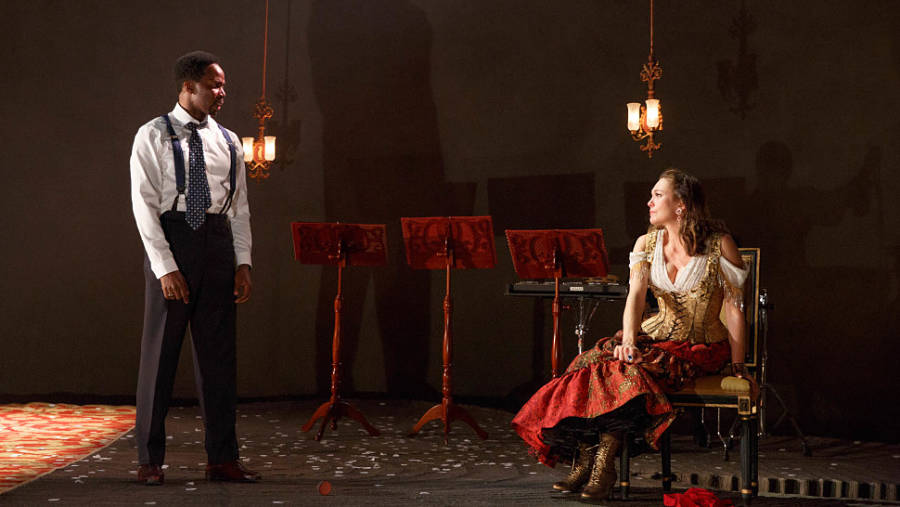To update, or not to update, that is the question….
Watching Simon Godwin’s transplanted production of The Cherry Orchard at the Roundabout, the audience receives a sudden jolt at the top of Act IV, when the actors make their entrances in modern dress. Wait a minute! I thought. Weren’t they in period costume during the first three acts? I had been so engrossed in the flow of Chekhov’s beautiful turn-of-the-20th-century play that I had hardly noticed—and that’s as it should be in a transporting production. But the sudden shift to modern dress (and modern behavior) pulled me out of the narrative, stopped the play in its tracks, and impeded my appreciation of those last, exquisite moments of Chekhov’s masterpiece.
I can understand what the director had in mind. After all, this is a play written in 1904 about the end of an old order, Tsarist Russia, and the eve of a new one. “Goodbye, old life! Hello, new life!” the young characters exclaim, heading off into a future whose outcome we now know. So we get the point. Even so, a startling choice like that should enlighten rather than distract and detract from the play’s momentum.

This artistic updating brought to mind others I’ve seen in recent years. Bartlett Sher’s decision to dress Tevye in contemporary clothes at the beginning and end of the revival of Fiddler on the Roof worked better, in my view, simply because he was the only character in the long line of emigrés leaving their home for the unknown who departed from the period look. It was thus a symbolic rather than a jarring, disorienting choice. Similarly, Phyllida Lloyd’s striking 2009 Broadway production of Maria Stuart, Schiller’s 1800 classic, featured Harriet Walter and Janet McTeer (as Elizabeth and Mary, Queen of Scots, respectively) clad in period dress, while the men of the court wore contemporary business suits—a cleaner conceit because it was introduced at the top.
This brings us to the inevitable question that every director of a classic faces: to update or not to update? And if so, how and how much? On that topic, legendary director Peter Brook once said, “Is one looking above all for an experience in the present? In that case every single play, whatever its background, whatever its period, must seem contemporary to the audience while they are watching it.” The question, then, is whether a director trusts a play to seem contemporary or feels the need to give us reminders, as in David Leveaux’s 2013 production of Romeo & Juliet on Broadway, in which Orlando Bloom entered the stage on a motorcycle. I saw it at a Wednesday matinee, and the young schoolgirls in attendance went wild; for others, it only disrupted the delicacy of Shakespeare’s love story.
There are some successful examples of updating. Spring Awakening, set to rock music by Duncan Sheik, ignited Wedekind’s 1891 classic when it opened on Broadway in 2009, and received a fresh infusion of life last year in Deaf West’s thrilling revival, directed by Michael Arden, which included deaf and physically challenged actors in the cast.
Directorial concepts aren’t just about time, of course, but location as well: I’ve seen a Czech-language Uncle Vanya set in West Texas, a French-language Seagull set in Provence, a Macbeth set in Nazi Germany, and Fiona Shaw’s mesmerizing modern-dress Medea, set in a glass house around a swimming pool. Some of these concept productions work; some don’t.
Every once in a while an update comes along that is so bold, so radical, and so total that it works, defying any theorizing or categorizing. This month I had the pleasure of seeing a sensational production of Cymbeline at Shakespeare’s Globe Theatre in London, under the leadership of the visionary Emma Rice, founder of Kneehigh Company (though her sudden dismissal by the theatre’s board has since been announced and hotly debated). Director Matthew Dunster’s production of this late Shakespearean “problem play” is called Imogen: William Shakespeare’s Cymbeline, Renamed and Reclaimed. And it is, fabulously, on both counts.
Called “a dance piece with text” by its artistic collaborators, Imogen is set in a harsh modern context of urban drug warfare wherein the actors, as rival gang members, dress in tracksuits and sneakers; the hoodie replaces the Elizabethan cloak, and the baseball cap provides a useful disguise. According to Dunster the choice of urban context reflects the violent content of Shakespeare’s story, which deals with a bride and groom (Imogen and Posthumous) forced to separate by cruel, warring factions, and features a wildly convoluted plot that finally unites them at the end. While Shakespeare’s text has been pared down, what’s spoken is faithful to the original, and together with Christopher Akrill’s exuberant hip/hop choreography, Lee Curran’s electrifying sound design, and some stunning aerial high-wire fight scenes, it’s a sensational mixture of the old and the new. (In a hint of the recent Spring Awakening, the cast, whose average age is mid-20s, included deaf and signing actors and a number of non-professionals.)
Watching the ecstatic young audience standing and cheering in the pit of the Globe Theatre, a line from Cymbeline sprang to mind: “Fortune brings in some boats that are not steered.” In this case, they were steered—but not by conventional interpretation or tentative, apparently random updating choices, but by talent, daring, and sheer inspiration.


